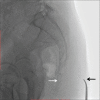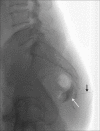Ganglion impar block in patients with chronic coccydynia
- PMID: 29089683
- PMCID: PMC5644328
- DOI: 10.4103/ijri.IJRI_294_16
Ganglion impar block in patients with chronic coccydynia
Abstract
Introduction: Coccydynia refers to pain in the terminal segment of the spinecaused by abnormal sitting and standing posture. Coccydynia is usually managed conservatively, however in nonresponsive patients, ganglion impar block is used as a good alternate modality for pain relief. This article studies the effect of ganglion impar block in coccydynia patients who were not relieved by conservative management.
Materials and methods: The study was carried out at the pain clinic in the departments of Physical Medicine and Rehabilitation and Radiology in a tertiary centre in India. It was a prospective hospital-based study, in which 35 patients with coccydynia were considered for fluoroscopy-guided trans-sacro-coccygeal ganglion impar block. The outcome assessment was done using Numerical Rating Scale (NRS) and Oswestry Disability Index (ODI) scores for a follow-up period of 6 months. Of the 35 patients, 4 were lost to follow-up. Analysis was done usingthe data from the remaining 31 patients.
Results: The mean age of the patients suffering from chronic coccydynia was 42.9 ± 8.39 years, and patients' age range was 28-57 years. The mean score of NRS and ODI before the procedure was 7.90 ± 0.16 and 48.97 ± 1.05, respectively. The interquartile range (IQR) of NRS score remained almost unchanged during pre and postprocedure, however, IQR of ODI varied during the pre and post procedural events. The NRS and ODI scores immediately after the procedure decreased drastically showing significant pain relief in patients, and the difference of scores till the end of study was statistically significant.
Conclusion: This study recommends the trans-sacro-coccygeal "needle inside needle" technique for local anesthetic block of the ganglion impar for pain relief in patients with coccydynia. This should be integrated with rehabilitative measures including ergonomical modification for prolonging pain free period.
Keywords: Coccydynia; NRS score; ODI score; ganglion impar block.
Conflict of interest statement
There are no conflicts of interest.
Figures


Similar articles
-
Assessment of Ganglion Impar Block Effect on Treatment Results of Coccydynia: A Cross-Sectional Study.Anesth Pain Med. 2024 Mar 7;14(2):e142137. doi: 10.5812/aapm-142137. eCollection 2024 Apr. Anesth Pain Med. 2024. PMID: 38741900 Free PMC article.
-
CT-guided injection for ganglion impar blockade: a radiological approach to the management of coccydynia.Clin Radiol. 2010 Jan;65(1):21-5. doi: 10.1016/j.crad.2009.08.007. Epub 2009 Oct 24. Clin Radiol. 2010. PMID: 20103417
-
Ganglion Impar Block For Chronic Coccydynia.J Ayub Med Coll Abbottabad. 2023 Feb-Mar;35(1):123-126. doi: 10.55519/JAMC-01-11092. J Ayub Med Coll Abbottabad. 2023. PMID: 36849391
-
Non-neurodestructive ganglion impar blocks for coccydynia and related disorders: a systematic review and meta-analysis.Reg Anesth Pain Med. 2025 May 28:rapm-2024-106055. doi: 10.1136/rapm-2024-106055. Online ahead of print. Reg Anesth Pain Med. 2025. PMID: 40081927 Review.
-
Imaging Coccygeal Trauma and Coccydynia.Radiographics. 2020 Jul-Aug;40(4):1090-1106. doi: 10.1148/rg.2020190132. Radiographics. 2020. PMID: 32609598 Review.
Cited by
-
Ganglion impar injection approaches and outcomes for coccydynia.Indian J Radiol Imaging. 2018 Oct-Dec;28(4):482-483. doi: 10.4103/ijri.IJRI_64_18. Indian J Radiol Imaging. 2018. PMID: 30662217 Free PMC article. No abstract available.
-
The Influence of Coccygeal Dynamic Patterns in Ganglion Impar Block for the Treatment of Chronic Refractory Coccydynia.J Orthop Case Rep. 2024 Nov;14(11):268-272. doi: 10.13107/jocr.2024.v14.i11.4990. J Orthop Case Rep. 2024. PMID: 39524288 Free PMC article.
-
Coccygeal Nerve Blockade vs. Impar Ganglion Blockade in Coccydynia: A Randomised Clinical Trial.Cureus. 2024 Sep 10;16(9):e69118. doi: 10.7759/cureus.69118. eCollection 2024 Sep. Cureus. 2024. PMID: 39398734 Free PMC article.
-
Ganglion Impar Block: A Magic Bullet to Fix Idiopathic Coccygodynia.Cureus. 2023 Jan 18;15(1):e33911. doi: 10.7759/cureus.33911. eCollection 2023 Jan. Cureus. 2023. PMID: 36819309 Free PMC article.
-
The influence of coccygeal dynamic patterns on ganglion impar block treatment results in chronic coccygodynia.Interv Neuroradiol. 2018 Oct;24(5):580-585. doi: 10.1177/1591019918781673. Epub 2018 Jul 3. Interv Neuroradiol. 2018. PMID: 29969959 Free PMC article.
References
-
- Maigne JY, Doursounian L, Chatellier G. Causes and mechanisms of common coccydynia: Role of body mass index and coccygeal trauma. Spine. 2000;25:3072–9. - PubMed
-
- Gunduz OH, Sencan S, Kenis-Coskun O. Pain Relief due to Transsacrococcygeal Ganglion Impar Block in Chronic Coccygodynia: A Pilot Study. Pain Med. 2015;16:1278–81. - PubMed
-
- Ellinas H, Sethna NF. Ganglion impar block for management of chronic coccydynia in an adolescent. PaediatrAnaesth. 2009;19:1137–8. - PubMed
-
- Trollegaard AM, Aarby NS, Hellberg S. Coccygectomy: An effective treatment option for chronic coccydynia: Retrospective results in 41 consecutive patients. J Bone Joint Surg Br. 2010;92:242–5. - PubMed
LinkOut - more resources
Full Text Sources
Other Literature Sources
Medical

